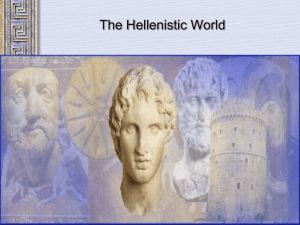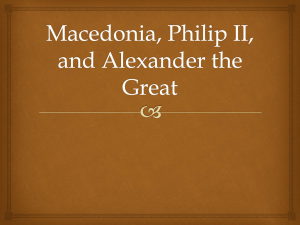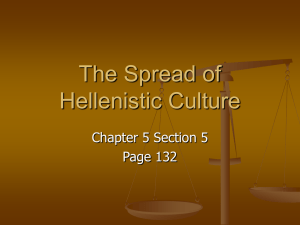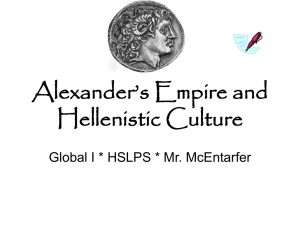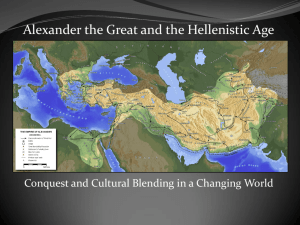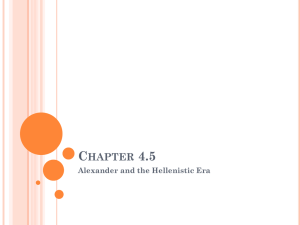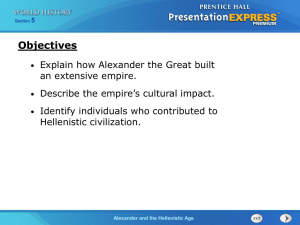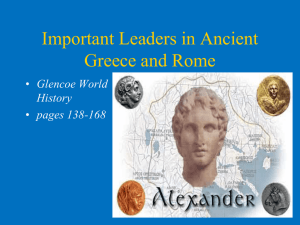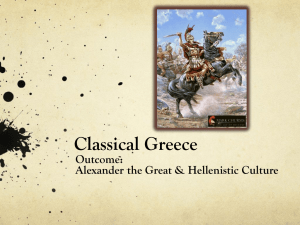ch 5 sec 3x - Mineral Point School
advertisement
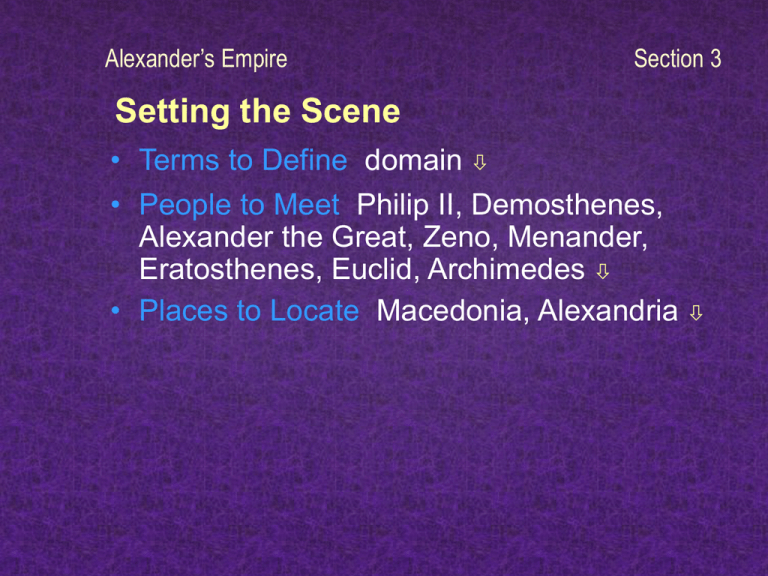
Alexander’s Empire Section 3 Setting the Scene • Terms to Define domain • People to Meet Philip II, Demosthenes, Alexander the Great, Zeno, Menander, Eratosthenes, Euclid, Archimedes • Places to Locate Macedonia, Alexandria Introduction • In the early 400s B.C., the Persians under Darius I and Xerxes tried but failed to conquer the Greeks. • Some 150 years later, the Macedonians made a similar attempt–and succeeded. Rise of Macedonia • The Macedonians, like the Spartans, were descended from the Dorians, and the Macedonian language incorporated many Greek words. • In 359 B.C. Philip II became king of Macedonia and was determined to do three things: create a strong standing army, unify the quarreling Greek citystates under Macedonian rule, and destroy the Persian Empire. Rise of Macedonia (cont.) • In 336 B.C. Philip was murdered–either by a Persian agent or by an assassin hired by his first wife, Olympias. • Olympias’ son Alexander, later known as Alexander the Great, became king. Rise of Macedonia (cont.) • Philip increased his army’s fighting power by organizing his infantry into Greek-style phalanxes. • The Greek city-states, weakened by the Peloponnesian War, would not cooperate in resisting Philip. • Despite the great Athenian orator Demosthenes’ appeal to his fellow citizens to fight for their liberty, Philip had conquered all of Greece, except for Sparta, by 338 B.C. Alexander’s Conquests • Alexander was only 20 when he became ruler of Macedonia and Greece. • Highly respected for his courage and military skill, Alexander was also extremely well educated, having been tutored by Aristotle. Conflict with Persia • In 334 B.C. Alexander led 30,000 soldiers and 5,000 cavalry into Asia to open his campaign of “West against East.” • Alexander’s first battle–and first victory– against the Persians took place at the Granicus River in western Asia Minor. • The second major battle–another victory for Alexander–took place at Issus, Syria, in 333 B.C. and forced the Persian king Darius III to flee. Conflict with Persia (cont.) • Alexander and his forces moved south. They captured the seaports of Phoenicia and cut off the Persian fleet from its main supply bases. The Persian fleet soon surrendered. • Next they invaded Egypt where the people, discontented under Persian rule, welcomed them and declared Alexander a pharaoh. Here Alexander founded a new city and named it Alexandria after himself. Final Campaigns • In 331 B.C. Alexander invaded Mesopotamia and smashed Darius’s main army in the battle of Gaugamela near the Tigris River. • Alexander went on to capture the key cities of the Persian Empire: Babylon, Persepolis, and Susa. • Darius was killed by one of his own generals, and Alexander declared himself ruler of the Persian Empire. Final Campaigns (cont.) • In 327 B.C. Alexander led his soldiers into India, and after three years they reached the Indus River valley. Alexander wanted to go farther, but his veteran soldiers refused. • Alexander reluctantly went back to Babylon, which he had made the capital of his empire. He then fell ill with a fever, probably malaria, and died in 323 B.C. at the age of 33. Map Supplement Imperial Goals • When Alexander first set out with his army, his goal was to punish Persia for its invasion of Greece 150 years earlier. • As he gained more and more territory, his new vision was to create an empire that would unite Europe and Asia and combine the best of Greek and Persian cultures. Imperial Goals (cont.) • Alexander adopted Persian dress and customs to promote their acceptance. • He also founded about 70 cities that served as military outposts and as centers for spreading the Greek culture and language throughout his empire. Divided Domain • Following Alexander’s death, three of his generals–Ptolemy, Seleucus, and Antigonus–eventually divided his vast empire into separate domains, or territories. • Ptolemy and his descendants ruled Egypt, Libya, and part of Syria. The most famous Ptolemaic ruler was Cleopatra VII, who lost her kingdom to the Romans in 31 B.C. Divided Domain (cont.) • Seleucus and his descendants–the Seleucids–at first controlled the rest of Syria, Mesopotamia, Iran, and Afghanistan. After a while, however, they were forced to give up their eastern territory and withdraw to Syria. • In 167 B.C. Jewish guerrillas led by Judah Maccabee challenged the Seleucid control over Palestine. • Two years later he succeeded in reoccupying Jerusalem, which would remain independent until the Romans defeated it in 63 B.C. Divided Domain (cont.) • The domain of Antigonus and his heirs consisted at first of Macedonia and Greece, but the Greek city-states soon declared their independence and started fighting each other again. • In the 100s B.C. the Roman Empire would conquer Macedonia and Greece. Section 3 Lecture Notes Hellenistic Culture • Although political unity disappeared after Alexander’s death, the Greek language and culture continued to spread in the lands he had conquered. • As Greek culture and Hellenic ways mixed with cultural elements of the Middle East, a new culture called Hellenistic emerged. Section 3 Lecture Notes City Life • Hellenistic culture was concentrated in the cities. The largest and wealthiest of these was Alexandria in Egypt. • Alexandria’s economic position benefited from a double harbor that could hold 1,200 ships at a time. Section 3 Lecture Notes City Life (cont.) • Alexandria was also a major intellectual center. • Its museum was the first ever and included a library of nearly a million volumes, an institute for scientific research, a zoo, and a botanical garden. • Around 250 B.C. Jewish scholars translated the Hebrew Bible into Greek. • This translation, known as the Septuagint, was later used by the apostle Paul and is still used by the Eastern Orthodox Church. Section 3 Lecture Notes City Life (cont.) • Greeks formed the upper class in Hellenistic society, and professional Greek soldiers and bureaucrats moved from place to place depending on where there were job opportunities. • In Alexandria and other Hellenistic cities, the social status of upper-class Greek women improved over their traditional status in Athens. Section 3 Lecture Notes Hellenistic Philosophers • Hellenistic philosophers focused on personal behavior, especially the question of how to achieve peace of mind. • Three systems of thought attracted most Hellenistic intellectuals: Cynicism, Epicureanism, and Stoicism. Section 3 Lecture Notes Hellenistic Philosophers (cont.) • The best known Cynic was Diogenes. He criticized materialism and asserted that people would be happier if they gave up luxuries and lived simply, in accord with nature. • The scholar Epicurus started the philosophy of Epicureanism. He argued that people should avoid both joy and pain by accepting the world as it was, ignoring politics, and living simply and quietly with a few close friends. Section 3 Lecture Notes Hellenistic Philosophers (cont.) • Zeno founded Stoicism. The name Stoicism comes from the Stoa Poikile, or “painted porch,” in which Zeno lectured. The Stoics believed that what happened to people was governed by natural laws. • Stoicism later affected both the Roman intellectuals and early Christian thinkers. Section 3 Lecture Notes Hellenistic Art and Literature • During the Hellenistic era, artists departed from Hellenic styles by showing people gripped by powerful emotions, not the idealized individuals of earlier times. • Hellenistic playwrights usually wrote comedies rather than tragedies. • Menander, the most famous Hellenistic playwright, wrote comedies about everyday life. Section 3 Lecture Notes Science, Medicine, and Mathematics • Although limited by simple instruments, Hellenistic scientists performed many experiments and developed new theories. • Aristarchus of Samos concluded that the sun is larger than the earth, that the earth rotates around the sun, and that the stars lie at immense distances from both heavenly bodies. Section 3 Lecture Notes Science, Medicine, and Mathematics (cont.) • Eratosthenes estimated the earth’s circumference to within 1 percent of the correct figure. • Hellenistic doctors dissected human corpses. They discovered the nervous system, studied the brain and the liver, and learned how to use drugs to relieve pain. Section 3 Lecture Notes Science, Medicine, and Mathematics (cont.) • Euclid of Alexandria wrote The Elements of Geometry, a book that organized all information about geometry. • Archimedes invented the compound pulley, which moves heavy objects easily, and the cylinder-screw, which is still used to lift water for irrigation. He also discovered the principle of buoyancy and demonstrated the principle of the lever.


